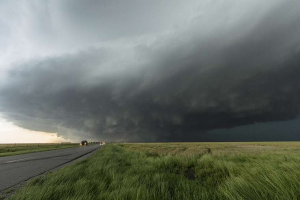Storms
By Michael FaginHistorical Weather Data, Weather ConditionsWith 0 commentsStorms. Spring 2018’s Severe Storms in the Midwest may be notably destructive. When warm air masses of the southern plains collide with downward-sloping, cool air from Canada, the atmosphere attempts to sort out its differences. The act of moving that air to perform the balancing act, when done rapidly, can evolve into the atmospheric tantrum called a severe storm in the Midwest.

Storms – Midwest
Spring Outlook
Why should residents of the mid-to-northern Midwest be aware of the weather this season? The concern regards the positionings in the seasonal outlook. Warmer than normal air is expected from Texas to Arizona. Colder than normal air will hang out around Montana and northward into Canada until later this spring. It will fend off the surplus of energy to the south as it arrives in the upper Midwest, west of the Great Lakes. The locations near the only slightly warmer than normal (33-40% probability) zone are there not because they won’t experience much of that southwestern heat heading northeast but rather because there should also be intermittent bouts of cold kissing them.
The precipitation outlook gives the upper Midwest, namely Wisconsin and Michigan, reason to expect plenty of wet. Drier humidities may couple with the predicted extra heat in Texas to help translate potential severe weather northward. The cool, northern air should also hold some extra moisture from its long terrestrial fetch, ending at the Great Lakes.
To what does all that add up? The moist, cool air from the northern Rockies to Minnesota will spill southeasterly into the southern Great Plains and conflict with the hot temperatures and dry humidities, namely from mid-to-late April to May. The conflict between the moist/cold and the dry/hot will manifest upstream: across the mid-to-upper Midwest. The characteristic movements of the air themselves are not a cause for alarm. The atypical factor that can lead toward a season being abnormally severe is when both sides of that equation are more pronounced than normal. The prediction may be ominous for a business owner expecting diminished productivity or a concerned property owner but it’s good news with which to start Spring 2018 if a Midwesterner who enjoys a good storm.
Future Economic Impact of Spring 2018’s Severe Storms in the Midwest
How will damages shape up to previous years? Foremost, it depends on where they’ll hit, before the quantity of storms in a particular year and even their intensities. It’s a given that the chances for damage increase as both of the latter factors increase but they don’t correlate with damage estimates as closely as seen with a population map.
The first event on record (since 1980) totalling over $2 billion in damages was May 1995’s striking of the southern Great Plains. Since then, during less active years, Midwesterners have endured $1-2 billion in damages. More active seasons may see $5 billion or more.
$7.5 billion in damages from Midwestern severe weather happened just last year. Two more notable recent years were 2016 with $11.4 billion and 2011 with $32.7 billion.Whether at the start of a season or hours before, it’s not possible, more than guessing luckily, to accurately foretell damage estimates. Having the necessary atmospheric ingredients doesn’t even promise that severe weather will form.
Although it does have its own weaknesses, a statistical crack at the numbers is the most sound numerical prediction strategy. A severe but not exceptionally catastrophic weather season per modern standards appears to mean a toll of about $10-15 billion, with much higher actual numbers possible if the positionings of storms happen to be exceptionally unfortunate – a rarity historically.
Are Storms in the Midwest Getting More Severe?
A reliable record of weather observation has only existed for much less than two hundred years, relative to the 4.543 billion year dating of the age of the Earth, so there is big room for naivete if trying to define normality. Many of history’s biggest and most memorable storms happened in the 1970s, when observations became truly wide-scale.
The devaluation of the dollar exaggerates the devastation of every new year’s severe storms. A whole city may have been worth a billion dollars at the turn of the previous century, whereas the same exact city may approach $100 billion now. Otherwise, the modern heightened financial impact is largely due to urban sprawl, economic growth, buying on credit using debt notes instead of with substance, etc. The question of whether or not storms are getting more severe is therefore much more complicated than a quick glance at the rising economic statistics.
The most important points when understanding severe spring storms in the Midwest are that they can rack up a lot of damage quickly and they’re very unpredictable. Their paths of devastation are typically narrow and, in each storm, there usually aren’t an abundance of straight-line wind and tornadic phenomena, thus significantly limiting the chance of affecting the relatively scant sections of the surface scraped where humans dwell and erect buildings. Widespread flooding and hurricanes affect giant swaths of often densely populated land, making the difference in their domination of weather-related damage totals. The numbers, however, don’t well convey the severity of getting squarely hit by a particularly severe Midwestern storm. Many of their unlucky victims would have gladly traded their grim, sometimes absolutely horrific experiences for some time in a run-of-the-mill hurricane.
Written by Meteorologist Geoff Linsley
